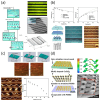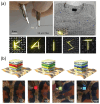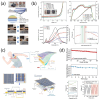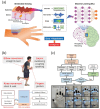Developments and Future Directions in Stretchable Display Technology: Materials, Architectures, and Applications
- PMID: 40731684
- PMCID: PMC12299469
- DOI: 10.3390/mi16070772
Developments and Future Directions in Stretchable Display Technology: Materials, Architectures, and Applications
Abstract
Stretchable display technology has rapidly evolved, enabling a new generation of flexible electronics with applications ranging from wearable healthcare and smart textiles to implantable biomedical devices and soft robotics. This review systematically presents recent advances in stretchable displays, focusing on intrinsic stretchable materials, wavy surface engineering, and hybrid integration strategies. The paper highlights critical breakthroughs in device architectures, energy-autonomous systems, durable encapsulation techniques, and the integration of artificial intelligence, which collectively address challenges in mechanical reliability, optical performance, and operational sustainability. Particular emphasis is placed on the development of high-resolution displays that maintain brightness and color fidelity under mechanical strain, and energy harvesting systems that facilitate self-powered operation. Durable encapsulation methods ensuring long-term stability against environmental factors such as moisture and oxygen are also examined. The fusion of stretchable electronics with AI offers transformative opportunities for intelligent sensing and adaptive human-machine interfaces. Despite significant progress, issues related to large-scale manufacturing, device miniaturization, and the trade-offs between stretchability and device performance remain. This review concludes by discussing future research directions aimed at overcoming these challenges and advancing multifunctional, robust, and scalable stretchable display systems poised to revolutionize flexible electronics applications.
Keywords: artificial intelligence integration; durable encapsulation; energy-autonomous systems; flexible electronics; high-resolution displays; soft robotics; stretchable displays; wearable healthcare.
Conflict of interest statement
The authors declare no conflict of interest.
Figures










Similar articles
-
Multi-Receptor Skin with Highly Sensitive Tele-Perception Somatosensory Flexible Electronics in Healthcare: Multimodal Sensing and AI-Powered Diagnostics.Adv Healthc Mater. 2025 Jul 6:e2502901. doi: 10.1002/adhm.202502901. Online ahead of print. Adv Healthc Mater. 2025. PMID: 40619754 Review.
-
All-3D-Printed PEDOT:PSS-Based Stretchable Thermoelectric Devices for Power Generation.ACS Appl Mater Interfaces. 2025 Jul 16;17(28):40836-40844. doi: 10.1021/acsami.5c03781. Epub 2025 Jul 1. ACS Appl Mater Interfaces. 2025. PMID: 40590897
-
Bioinspired Omnidirectional Interface Engineered Flexible Island for Highly Stretchable Electronics.Small. 2025 Aug;21(32):e2410247. doi: 10.1002/smll.202410247. Epub 2025 Jan 31. Small. 2025. PMID: 39891029
-
Molecular Gridization of Organic Semiconducting π Backbones.Acc Chem Res. 2025 Jul 1;58(13):1982-1996. doi: 10.1021/acs.accounts.5c00180. Epub 2025 Jun 13. Acc Chem Res. 2025. PMID: 40512962
-
Advancements in MXene-based composites for electronic skins.J Mater Chem B. 2024 Jan 24;12(4):895-915. doi: 10.1039/d3tb02247a. J Mater Chem B. 2024. PMID: 38194290 Review.
References
Publication types
LinkOut - more resources
Full Text Sources

